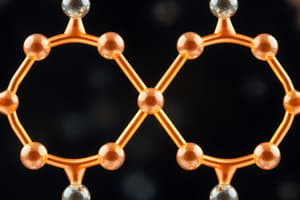Podcast
Questions and Answers
Which intermolecular force is NOT present in HCl?
Which intermolecular force is NOT present in HCl?
- Dispersion forces
- Hydrogen bonding (correct)
- London forces
- Dipole–dipole interactions
Which of the following pairs has the compound with stronger intermolecular forces?
Which of the following pairs has the compound with stronger intermolecular forces?
- H2O or HCl (correct)
- HBr or CO2
- CH4 or H2
- C2H6 or H2
Which compound can exhibit both intermolecular and intramolecular hydrogen bonding?
Which compound can exhibit both intermolecular and intramolecular hydrogen bonding?
- HF
- NH3 (correct)
- CH3Cl
- H2O
Which bond is more polar based on electronegativity differences?
Which bond is more polar based on electronegativity differences?
What type of intermolecular force is present in ammonia (NH3)?
What type of intermolecular force is present in ammonia (NH3)?
What characterizes an ionic bond?
What characterizes an ionic bond?
Which statement about covalent bonds is true?
Which statement about covalent bonds is true?
What is a characteristic of a coordinate bond?
What is a characteristic of a coordinate bond?
In a Lewis structure, how are valence electrons represented?
In a Lewis structure, how are valence electrons represented?
Which of the following represents a triple covalent bond?
Which of the following represents a triple covalent bond?
What is the number of valence electrons in a phosphorus atom?
What is the number of valence electrons in a phosphorus atom?
In the Lewis structure of water (H2O), how many total valence electrons are shared between hydrogen and oxygen?
In the Lewis structure of water (H2O), how many total valence electrons are shared between hydrogen and oxygen?
Which of the following elements would most likely be found as a diatomic molecule?
Which of the following elements would most likely be found as a diatomic molecule?
What type of bond exists between the two hydrogen atoms in H2 according to Lewis theory?
What type of bond exists between the two hydrogen atoms in H2 according to Lewis theory?
Which of the following correctly describes the Lewis structure of oxygen in an O2 molecule?
Which of the following correctly describes the Lewis structure of oxygen in an O2 molecule?
What configuration do hydrogen atoms adopt when they bond in a molecule such as H2?
What configuration do hydrogen atoms adopt when they bond in a molecule such as H2?
Which of the following compounds will have a Lewis structure that exhibits a double bond?
Which of the following compounds will have a Lewis structure that exhibits a double bond?
When considering the bond type between magnesium and iodine, what will it typically be classified as?
When considering the bond type between magnesium and iodine, what will it typically be classified as?
Based on Lewis structures, why does nitrogen typically exist as a diatomic molecule (N2)?
Based on Lewis structures, why does nitrogen typically exist as a diatomic molecule (N2)?
Which of the following elements does NOT typically form a stable ion based on its Lewis structure?
Which of the following elements does NOT typically form a stable ion based on its Lewis structure?
Flashcards
Ionic Bond
Ionic Bond
A chemical bond formed when electrons are transferred between atoms, resulting in oppositely charged ions that attract each other.
Covalent Bond
Covalent Bond
A chemical bond formed when two atoms share electrons.
Intermolecular Forces in HCl
Intermolecular Forces in HCl
HCl molecules experience London dispersion forces only due to the absence of hydrogen bonding.
Intermolecular Forces in C2H6
Intermolecular Forces in C2H6
Signup and view all the flashcards
Covalent Bond Types
Covalent Bond Types
Signup and view all the flashcards
Coordinate Bond
Coordinate Bond
Signup and view all the flashcards
Intermolecular Forces in NH3
Intermolecular Forces in NH3
Signup and view all the flashcards
Lewis Structures
Lewis Structures
Signup and view all the flashcards
Electronegativity
Electronegativity
Signup and view all the flashcards
Bond Polarity
Bond Polarity
Signup and view all the flashcards
Lewis dot structure of Oxygen
Lewis dot structure of Oxygen
Signup and view all the flashcards
Valence electrons
Valence electrons
Signup and view all the flashcards
Lewis structure of Phosphorus
Lewis structure of Phosphorus
Signup and view all the flashcards
Octet Rule
Octet Rule
Signup and view all the flashcards
Diatomic Molecule
Diatomic Molecule
Signup and view all the flashcards
Duet Rule
Duet Rule
Signup and view all the flashcards
Electron Configuration
Electron Configuration
Signup and view all the flashcards
Lewis structure of H2
Lewis structure of H2
Signup and view all the flashcards
Lewis structure for Ionic Compounds
Lewis structure for Ionic Compounds
Signup and view all the flashcards
Study Notes
Chemical Bonds
-
Chemical bonds are classified into three types based on the atoms involved: ionic, covalent, and metallic.
-
Ionic bond: Forms when electrons are transferred between atoms, creating oppositely charged ions that attract each other. Generally forms when a metal bonds with a nonmetal. The method is electron transfer.
-
Covalent bond: Forms when two atoms share some of their electrons. Generally forms when nonmetal atoms bond together. The method is electron sharing.
-
Metallic bond: Forms when metal and metal atoms bond. Electrons are pooled.
-
Types of Atoms and Corresponding Bonds:
- Metal and nonmetal → Ionic bond
- Nonmetal and nonmetal → Covalent bond
- Metal and metal → Metallic bond
The Ionic Bond
- Ionic bonds form when electrons are transferred between atoms, creating oppositely charged ions.
- This usually happens when a metal bonds to a nonmetal.
- The method is electron transfer. This results in a compound with a crystalline lattice structure.
- Ions formed are called cations (positive) and anions (negative).
The Covalent Bond
- Covalent bonds form when atoms share electrons.
- This typically occurs between nonmetal atoms.
- The shared electrons hold the atoms together by attracting the nuclei of both.
- The method is electron sharing.
- Covalent bonds can be single, double, or triple, depending on how many electron pairs are shared.
- Single covalent bond: one electron pair shared (2 electrons)
- Double covalent bond: two electron pairs shared (4 electrons)
- Triple covalent bond: three electron pairs shared (6 electrons)
The Coordinate Bond
- A coordinate bond, also called a dative covalent bond, is a covalent bond where both electrons originate from the same atom.
- One atom (donor/Lewis base) provides a lone pair of electrons, and another atom (acceptor/Lewis acid) accepts them.
- Lewis acid: electron pair acceptor
- Lewis base: electron pair donor
Representing Valence Electrons (Lewis Structures)
- Lewis structures are diagrams that show valence electrons in main group elements as dots.
- The number of valence electrons is equal to the group number in the periodic table (except for helium).
- Dots are placed around the element's symbol, with a maximum of two dots per side initially. Single dots are placed first before pairing.
Intermolecular Forces
- Intermolecular forces are the attractive forces between molecules.
- They are generally much weaker than the intramolecular forces holding atoms together within a molecule.
- These forces influence various physical properties:
- Melting and boiling points
- Solubility
- Rate and outcome of chemical reactions
Intermolecular Forces in Covalent Molecules
- Three types of intermolecular forces in covalent molecules, ranked by increasing strength:
- London dispersion forces: Very weak forces caused by temporary changes in electron density. Strength increases with molecular size.
- Dipole-dipole interactions: Moderate forces between permanent dipoles in polar molecules. Dipoles align so that opposite charges are close.
- Hydrogen bonding: Strong forces between molecules where a hydrogen atom bonded to a highly electronegative atom (O, N, or F) is attracted to another electronegative atom in another molecule.
Ion-Dipole Forces
- Ion-dipole forces are electrostatic attractions between a charged ion and a polar molecule.
- These forces are common in solutions, particularly for ionic compounds dissolving in polar solvents like water.
- The strength of the ion-dipole interaction is proportional to:
- The charge on the ion
- The magnitude of the dipole moment of the molecule.
Studying That Suits You
Use AI to generate personalized quizzes and flashcards to suit your learning preferences.




